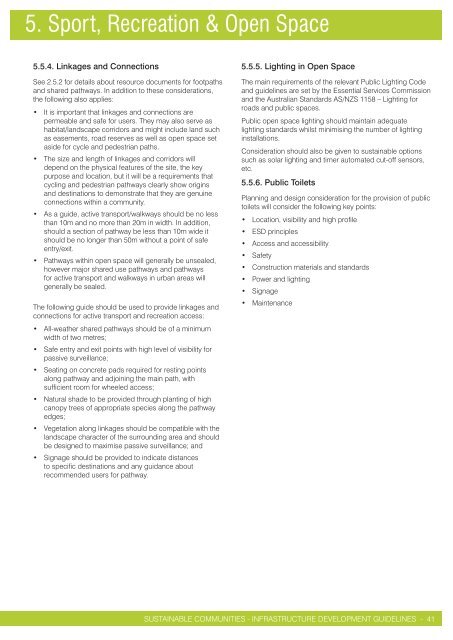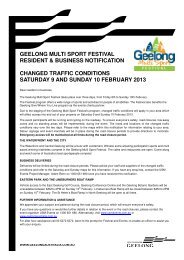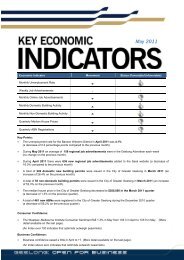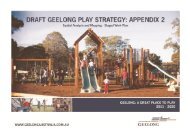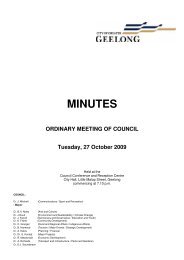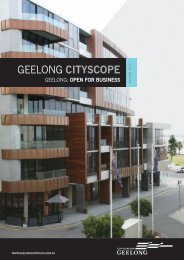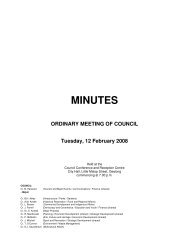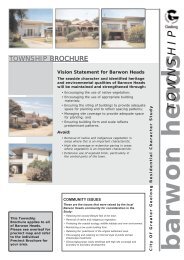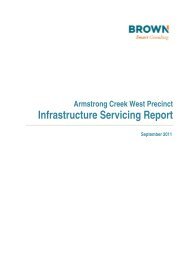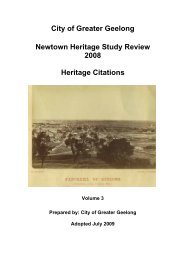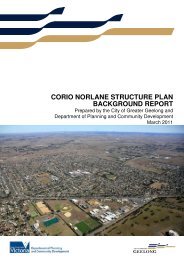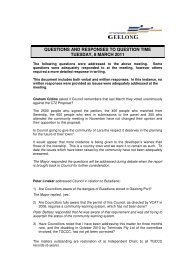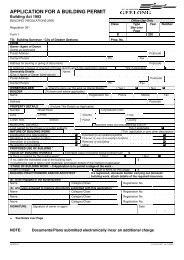5. Sport, Recreation & Open Space - City of Greater Geelong
5. Sport, Recreation & Open Space - City of Greater Geelong
5. Sport, Recreation & Open Space - City of Greater Geelong
You also want an ePaper? Increase the reach of your titles
YUMPU automatically turns print PDFs into web optimized ePapers that Google loves.
<strong>5.</strong> <strong>Sport</strong>, <strong>Recreation</strong> & <strong>Open</strong> <strong>Space</strong><br />
<strong>5.</strong><strong>5.</strong>4. Linkages and Connections<br />
See 2.<strong>5.</strong>2 for details about resource documents for footpaths<br />
and shared pathways. In addition to these considerations,<br />
the following also applies:<br />
• It is important that linkages and connections are<br />
permeable and safe for users. They may also serve as<br />
habitat/landscape corridors and might include land such<br />
as easements, road reserves as well as open space set<br />
aside for cycle and pedestrian paths.<br />
• The size and length <strong>of</strong> linkages and corridors will<br />
depend on the physical features <strong>of</strong> the site, the key<br />
purpose and location, but it will be a requirements that<br />
cycling and pedestrian pathways clearly show origins<br />
and destinations to demonstrate that they are genuine<br />
connections within a community.<br />
• As a guide, active transport/walkways should be no less<br />
than 10m and no more than 20m in width. In addition,<br />
should a section <strong>of</strong> pathway be less than 10m wide it<br />
should be no longer than 50m without a point <strong>of</strong> safe<br />
entry/exit.<br />
• Pathways within open space will generally be unsealed,<br />
however major shared use pathways and pathways<br />
for active transport and walkways in urban areas will<br />
generally be sealed.<br />
The following guide should be used to provide linkages and<br />
connections for active transport and recreation access:<br />
• All-weather shared pathways should be <strong>of</strong> a minimum<br />
width <strong>of</strong> two metres;<br />
• Safe entry and exit points with high level <strong>of</strong> visibility for<br />
passive surveillance;<br />
• Seating on concrete pads required for resting points<br />
along pathway and adjoining the main path, with<br />
sufficient room for wheeled access;<br />
• Natural shade to be provided through planting <strong>of</strong> high<br />
canopy trees <strong>of</strong> appropriate species along the pathway<br />
edges;<br />
• Vegetation along linkages should be compatible with the<br />
landscape character <strong>of</strong> the surrounding area and should<br />
be designed to maximise passive surveillance; and<br />
• Signage should be provided to indicate distances<br />
to specific destinations and any guidance about<br />
recommended users for pathway.<br />
<strong>5.</strong><strong>5.</strong><strong>5.</strong> Lighting in <strong>Open</strong> <strong>Space</strong><br />
The main requirements <strong>of</strong> the relevant Public Lighting Code<br />
and guidelines are set by the Essential Services Commission<br />
and the Australian Standards AS/NZS 1158 – Lighting for<br />
roads and public spaces.<br />
Public open space lighting should maintain adequate<br />
lighting standards whilst minimising the number <strong>of</strong> lighting<br />
installations.<br />
Consideration should also be given to sustainable options<br />
such as solar lighting and timer automated cut-<strong>of</strong>f sensors,<br />
etc.<br />
<strong>5.</strong><strong>5.</strong>6. Public Toilets<br />
Planning and design consideration for the provision <strong>of</strong> public<br />
toilets will consider the following key points:<br />
• Location, visibility and high pr<strong>of</strong>ile<br />
• ESD principles<br />
• Access and accessibility<br />
• Safety<br />
• Construction materials and standards<br />
• Power and lighting<br />
• Signage<br />
• Maintenance<br />
SUSTAINABLE COMMUNITIES - INFRASTRUCTURE DEVELOPMENT GUIDELINES - 41


